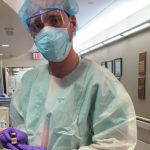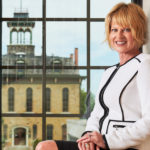Hannah Greer, ’20, (above) says her first year of teaching has been a wild ride.
Greer, who teaches freshman and sophomore English at Olathe (Kansas) South High School, acknowledges that any first year would be tough and chaotic for a new teacher, but having the challenges of a pandemic on top of that has added to her stress.
“I have had to adapt by using more technology, being very flexible with my plans for each lesson—nothing goes as planned through a computer screen or when reliant on ever-changing guidelines due to COVID—and by increasing communication with students and parents,” she said.
In stride
Associate Professor of Education Dr. Amy Wintermantel said the technology tools future teachers learn to use at Baker are easily applied to in-person, remote, or hybrid learning. She’s been in contact with several recent graduates to see how they’re adapting.
“Graduates I’ve talked to seem to be taking the dramatic shift in delivery in stride. On one level, the younger grads probably had a unique advantage because they were not in a solid routine of teaching only on ground. All of our education candidates have at least two online education courses, so they have seen quality online instruction.”
Dr. Amy Wintermantel, associate professor education
Dr. Charlsie Prosser, department chair and associate professor of education, said Baker’s classrooms have changed in a variety of ways since the start of the pandemic.
“Some professors are using a blended approach of in-class and online instruction. Outdoor classrooms are available across campus, and a few professors are teaching all online” she said. “Given the variety in the way education students are attending classes, we are able to focus on the importance of being flexible in all types of learning environments through modeling and discussing how this would look in an elementary or secondary classroom.”
Everything was normal
Kendall Stelting, ’19, started her first year of teaching kindergarten in the fall of 2019 at Bertram Caruthers Elementary School in Kansas City, Kansas.
“Everything was normal stress for a first-year teacher, and when word started to spread about the pandemic, we all were just as normal as anyone else thinking it would blow over,” she said. “We didn’t realize the severity of it all. Now, we are in a remote-learning setting. I work nearly 10 hours a day Monday through Friday answering calls, worries, and questions and helping students understand materials and getting families home desks and supplies if they need it.”
Prosser said professors know it isn’t possible to prepare graduates like Greer and Stelting for all of the changes and new ways of learning they might experience during their career, but she is confident Baker’s focus on problem solving, critical thinking, and collaborative teams prepares them for whatever the future holds. And this has been reinforced during the pandemic.
“We see grads reaching out to one another for assistance with new instructional tools and with words of encouragement as needed,” she said. “Also, it seems most school districts are providing support and professional development.”
Education veterans offer resources
Helping families adjust to remote learning is one way Jen Upton knew she could help during the pandemic. Upton graduated from Baker with a bachelor’s degree in music education in 1998 and a master’s degree in education in 2001. Last spring, she started a Facebook group—COVID-19 Home Education Resources—offering resources for parents. It now has over 75,000 members.
Upton said at first, the group was a place for parents to share extracurricular activities to keep kids engaged and busy during the extra weeks of spring break. When schools began to close for the rest of the school year and stay-at-home orders began, parents and educators started sharing more core curricular resources, as well as technology-related resources.
“There were many questions at first about how to organize the day for at-home students and how to set up an at-home learning space. Luckily, many teachers are also members, so they have great advice, as well as many full-time homeschool parents who have helped calm nerves and show different ways to teach children at home. This was especially relevant in July and August as reopening of schools began and parents were making choices of whether to fully homeschool their children, use their school’s remote learning or hybrid learning models, or to send them back full time to school if that was an option.”
Jen Upton, creator of COVID-19 Home Education Resources Facebook group
Upton, who taught in public education for 13 years before deciding to stay home with her children, said she’s always used what she learned at Baker to help supplement her children’s education. And it was especially helpful during quarantine.
Grace, flexibility, and ingenuity
The realities of the virtual environment have spurred Stelting to find new ways to help her students understand new concepts—using a puppet, dancing around her room, or dressing like a character from a book series.
“Teaching and learning are still occurring. More than anything, though, I’ve made deep connections with these kids even through a screen alone. I believe there are people who are specifically built to be a teacher, and I am one of them. We do hard things every day and, while this is extremely challenging, it is no different.”
Kendall Stelting, ’19, kindergarten teacher
For Greer, it has been difficult to build relationships with her high school students virtually and in a situation where she only sees them every other day.
“We take nonverbal signals for granted,” she said. “Teachers depend on nonverbal signals to check for understanding of content and to gauge social and emotional levels of students. These signals are very limited across a computer screen.”
For this reason, when Greer has more time with her students in the classroom, she will not take face-to-face interactions for granted and will plan more lessons away from the computer, focusing on relationships, nature, and self-awareness.
Greer said teachers are doing their best to meet their students’ needs in a world that lacks stability and structure right now, and she was recently reminded that she is making a difference.
“Students in my class were asked to write an email to a teacher they wanted to thank,” Greer said. “Many chose me. The sentiments students shared reinforced my joy for this job. As cheesy as it might be to say this, the students are impacting me back. I am growing and challenging myself because I want to be better for my students.”
Credits:
Written by Jenalea Myers, '08








